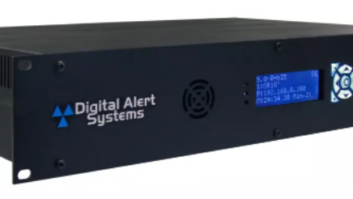Model 320D Features a Dynamic Release Computer for Analysis of Audio Input Density
(click thumbnail)
The Compellor Model 320D dual-channel automatic level controller with analog and digital I/O continues Aphex Systems’ audio processing lineage by adding digital I/O access to the analog Compellor 320A.
Featuring the familiar 320A faceplate, this two-channel mono/linked-stereo device provides transparent control of dynamic audio levels. Allow me to describe what is happening to the audio signal once inside the single rack-space unit.
Instead of simply limiting or compressing audio signals, the Compellor interacts with them using three discrete gain controllers in combination: a frequency-discriminate leveler, a compressor and a limiter, working interactively. A leveler utilizes a high-compression ratio and a slow attack and release (20:1). A compressor utilizes a low-compression ratio and a fast attack and release (1.1:1 to 3:1 program dependent). A limiter uses a high-compression ratio and still faster attack and release (>30:1).
Additionally, the 320D includes a dynamic release computer, a dynamic verification gate and a silence gate to intelligently deliver a substantial amount of signal processing with the least noticeable processing effects.
Controlled release
Yes, I hear you. “Um, what is a dynamic release computer?” That is what I asked Marvin Caesar, president of Aphex Systems.
He said the DRC measures the incoming audio density, which he defined as peak-to-average ratio. A female voice, for example, which may have a 12-15 dB peak-to-average ratio, differs from a male voice, which might have only a 6 to 8 dB peak-to-average ratio. When viewing these signals on a peak reading meter, the peaks may read the same, but the male voice will be substantially louder due to its higher average level.
The DRC analyzes the density of the audio input, and if it is dense, DRC will provide a slower release time. If the audio is less dense, a faster release is assigned. This allows a variety of audio sources to be processed differently, but the resulting audio to have similar volume and dynamics.
Imagine the difference in “density” of an epiglottal-thrusting disc jockey playing top 40 music and a public television talk show with both a male and female host. The 320D Compellor is an appropriate manager for both applications.
“Ok, now what’s a dynamic verification gate?”
Glad you asked. Caesar gave me this example: In speech, there is usually a big spike on the consonants, then a soft area (or pause) and then another spike of similar intensity. In music, especially pop, there are regular spikes at both the kick and snare hits. A traditional compressor attacks the first spike, releases it and then attacks the next one, often interfering with the naturally played dynamics.
The DVG attacks the first spike, and freezes at that level for about one second, intuiting that another spike will be along shortly. This permits a more natural sounding form of level control and prevents audible “pumping” that engineers work so hard to avoid.
Now I suspect you presume you know what the 320D “silence gate” is. Nope, this gate does not affect the main audio path, but rather the gain control functions, causing the gain to either “freeze” at the last known level (which would be silence) or continue being controlled when audio resumed. If program stops for any reason, the DVG first freezes the VCA gain, then relinquishes all control after about 1.5 seconds of silence. The Compellor, by design, would then recover gain and the background noise floor would be brought up. To prevent this, the Silence Gate circuit keeps the VCA gain at the user-selected silence threshold until it is crossed by ensuing audio.
Transparent sound
Yeah, that all reads well, but how does it sound? Simply put, it doesn’t. By following Aphex’s recommended parameter settings, the only effect I achieved was an increase in the “perceived” audio level. In an effort to stress the audio by using extreme processing – turning the Process knob first completely to the “Level” and then all the way to “Compress” settings, then turning the “Drive” knob all the way up – I could not get the audio to sound “crushed.”
I am astonished by the transparency that even ridiculously heavy settings produce, providing me with substantially louder levels without increasing peak volume or hearing objectionable artifacts. When using reasonable settings, I had to check my console PPM meters to verify the device was working. How do they do that?
Offline, I routed a newscast – voice and actualities only – through the unit’s analog connectors. Our anchors use their own dynamic control when speaking, and using Aphex’s prescribed settings, I was able to get 8 VU more gain out of their performance without audibly impacting it.
Additionally, the voices of the reporters – many of whom were on satphones, landlines or cellophones – sounded fuller, less shrill and more evenly balanced with the announcers, who use an unprocessed Neumann U87. I then bypassed the unit at the end of the ‘cast, and the following program’s music billboard and elements were simply dwarfed in comparison.
Going through the Compellor via AES/EBU and using it in a mastering tool application, I played a stereo mix of a big dynamic multi-track music production on which I am working. I was able to adjust the 320D so that my digital console registered a nearly solid .5 dBFS and yet I heard none of the “squashing” and harsh tonality so familiar to over-compression. It made my recording warm, fat and big-sounding – just like the major-label releases I was using for my A/B comparisons.
Operable at -10 dBv, +4 dBu and +8 dBu (via XLR connectors), the Aphex 320D Compellor has a bi-color LED meter for status information; a hard-wire bypass that is silently established if power fails (valuable for mission critical program); audio that is present at both analog and digital outputs regardless of input source (!); and an excellent owner’s manual that goes well beyond the operation of the device and into wiring illustrations, definitions and a coherent overview of fundamental scientific practices and theory.
Applications include recording, mixing, mastering, video post-production, sound reinforcement, broadcast pre-processing broadcast STL, TV broadcasting and cable systems, video and audio tape duplication, voice processing and hard-disk recording. Whew.
I’m impressed with the Aphex Systems engineers’ understanding of, dare I say affection for, audio. This company subscribes to the medical doctors’ credo of “Above all, do no harm.”













